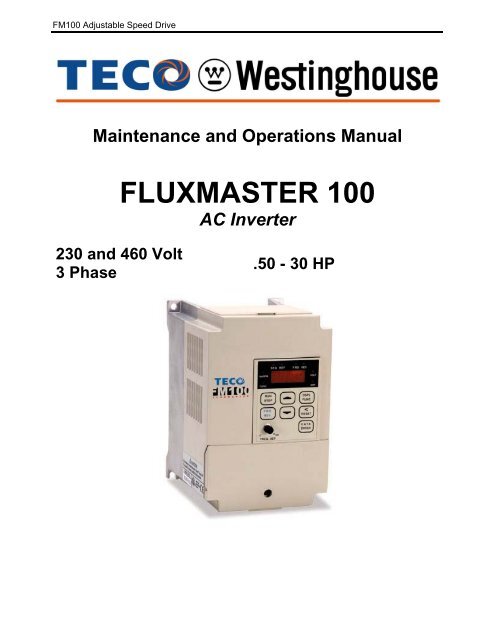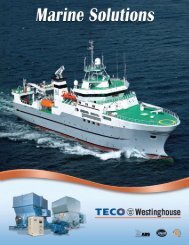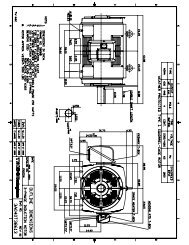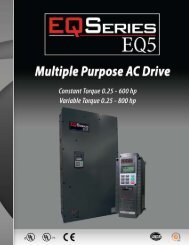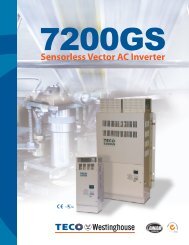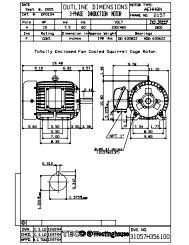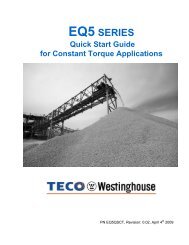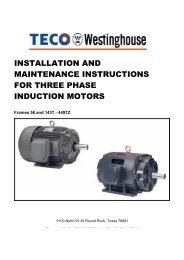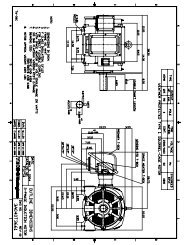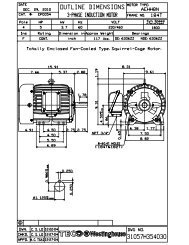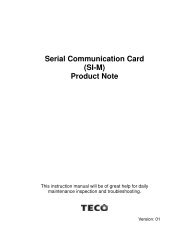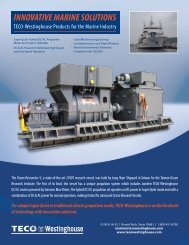FM100 Maintenance & Operations Manual - TECO-Westinghouse ...
FM100 Maintenance & Operations Manual - TECO-Westinghouse ...
FM100 Maintenance & Operations Manual - TECO-Westinghouse ...
- No tags were found...
Create successful ePaper yourself
Turn your PDF publications into a flip-book with our unique Google optimized e-Paper software.
<strong>FM100</strong> Adjustable Speed Drive<strong>Maintenance</strong> and <strong>Operations</strong> <strong>Manual</strong>FLUXMASTER 100AC Inverter230 and 460 Volt3 Phase.50 - 30 HP
<strong>Maintenance</strong> and <strong>Operations</strong> <strong>Manual</strong>Table of ContentsForeword..........................................................................................................1Precautions for Operation ................................................................................3Environmental Precautions ..............................................................................5General Information .........................................................................................7Specifications...................................................................................................9Wiring.............................................................................................................11Keypad Operation ..........................................................................................14Parameter List................................................................................................15Function Description ......................................................................................23Fault Codes....................................................................................................53<strong>Maintenance</strong> Section…………………………………………………………….. 58Dimensions…………………………………………………………………………63Braking Resistors…………….……………………………………………………64i
ForewordTo fully employ all the functions of this Inverter, and to ensure the safety for its users, pleaseread through this operations manual in detail. Should you have any further questions, pleasecontact your local <strong>TECO</strong>-<strong>Westinghouse</strong> distributor or regional sales representative.: Please use Precaution with this ProductThe Inverter is a power electronic device. For safety reasons, please read carefully thoseparagraphs with “WARNING” or “CAUTION” symbols. They are important safety precautionsto be aware of while transporting, installing, operating and examining the Inverter. Pleasefollow these precautions to ensure your safety.WARNINGCAUTIONPersonal injury may result from improper operation.The Inverter or mechanical system may be damaged by improperoperation.WARNING• Do not touch the PCB or components on the PCB right after power has been turnedOFF. Charging indicator light must be OFF before examining the components.• Do not attempt to wire circuitry while power is ON. Do not attempt to examine thecomponents and signals on the PCB while the Inverter is operating.• Do not attempt to disassemble or modify internal circuitry, wiring, or components ofthe Inverter while power is ON.• The Inverter frame must be connected to ground with a suitably rated cable,connected to the Ground Terminal on the Inverter.CAUTION• Do not attempt to perform dielectric strength test to internal components of theInverter. The Inverter contains sensitive semiconductor devices that are vulnerableto high voltages.• Do not connect the output terminals: T1, T2 and T3 to AC power input.• The CMOS IC on the primary PCB of the Inverter is vulnerable to static electricalcharges. Do not handle the primary PCB without the use of proper anti-staticequipment.1
Examination Before InstallationEvery <strong>FM100</strong> has been fully tested and examined before shipment. Please carry out thefollowing examination procedures after unpacking your Inverter.• Check to see if the model number of the Inverter matches the model number of theInverter that you have ordered.• Check to see whether any damage occurred to the Inverter during shipment. Do notconnect the Inverter to the power supply if there is any sign of damage.Report any damage that may have occurred to the Inverter during shipment to the freightcarrier and your local <strong>TECO</strong>-<strong>Westinghouse</strong> distributor or regional sales representative.2
Precautions for OperationBefore Turning ON PowerCAUTIONChoose the appropriate power source with correct voltage settings for the inputvoltage specification of the Inverter.WARNINGSpecial care must be taken while wiring the primary circuitry panel. The L1, L2 and L3terminals must be connected to the input power source and must not be mistakenlyconnected to T1, T2 or T3 output terminals. This may damage the Inverter when thepower is turned ON.CAUTION• Do not attempt to transport the Inverter by the front cover. Securely hold theInverter by the heatsink mounting chassis to prevent the Inverter from falling.Failure to do so may cause personal injury or damage to the Inverter.• Install the Inverter onto a firm metal baseplate or a non-flammable type material.Do not install the Inverter onto or nearby any flammable material.• An additional cooling fan may need to be installed if several Inverters are installedinto one control panel. The temperature inside an enclosed panel should be below104 o F (40 o C) to avoid overheating.• Turn OFF the power supply before performing any work in the control panel. Carryout installation procedures according to instructions. This will help avoid a situationthat may result in an operational malfunction.• This product is not provided with overspeed protection.• This product is only intended for use in a clean dust and moisture free environment.When Power is AppliedWARNINGDo not attempt to install or remove input or output connectors of Inverter while thepower supply is turned ON. Otherwise, the Inverter may be damaged due to thesurge peak caused by the insertion or removal of power.3
Under OperationWARNINGDo not use a separate device to switch the motor ON or OFF during operation. TheInverter may experience an overcurrent failure.WARNING• To avoid personal injury caused by electrical shock, do not remove the frontcover of the Inverter while the power is ON.• When the automatic restart function is enabled, the motor and machinery willrestart automatically.CAUTION• Do not touch the heatsink base during operation.• The Inverter can be easily operated at low and high speed ranges. Pleasereconfirm the operating range of the motor and machinery you are controlling.• Do not examine the signals on the PCB of the Inverter during operation.• All Inverters are properly adjusted and factory set before delivery.CAUTIONDo not proceed with disassembly or examination of the Inverter before ensuring thatthe power is OFF and that the Power LED has extinguished.Performing an Examination or <strong>Maintenance</strong>CAUTIONThe environment ambient temperature should be within 14 O F ~ 104 O F (-10 O C ~40 O C), with humidity under 95% non-condensing. The Inverter should be free fromdripping water and metal dust.4
Environmental PrecautionsoilAvoid direct sunlightKeep away from corrosivegases and liquidsKeep away from oil,grease and gasKeep away from saltyenvironmentsKeep away from rainand dripping waterAvoid dusty environmentsAvoid excessive vibrationAvoid excessive direct heatAvoid high temperatureenvironmentsKeep away from highelectrical magnetic wavesKeep away fromradioactive matterKeep away fromflammable material5
Hardware Instructions and InstallationOperating ConditionsThe installation site of the Inverter is important. It has a direct relationship on the functionalityand life span of your Inverter. Please carefully consider the following requirements whenchoosing an installation site:• Mount the unit vertically.• Inverter ambient temperature should be within• Environment ambient temperature should be within 14 o F ~ 104 o F (-10 o C ~ 40 o C).• Avoid placing the Inverter close to any heating equipment.• Avoid dripping water and humid environments.• Avoid direct sunlight.• Avoid oil, grease and gas.• Avoid contact with corrosive gases and liquids.• Prevent foreign dusts, flocks, or metal scraps from contacting the Inverter.• Avoid electric magnetic interference (soldering or power machinery).• Avoid excessive vibration. If vibration cannot be avoided, an anti-vibration mountingdevice should be installed to reduce vibration.• If the Inverter is installed in an enclosed control panel, please add additional coolingusing an external fan. This will allow additional airflow and cooling.• Placement of external fans should be directly over the top of the Inverter.• For proper installation of the Inverter, you must place the front side of the Inverter facingfront and the top of the Inverter in the up direction for proper heat dissipation.Ventilation &Installation DirectionFront & Side Views6
General Information:GeneralThe <strong>FM100</strong> series is a General Purpose Inverter that incorporates a high efficiency Pulse WidthModulated (PWM) design and advanced IGBT technology. The output closely approximates asinusoidal current waveform to allow variable speed control for any conventional squirrel cageinduction motor.ReceivingThis unit has been put through demanding tests at the factory prior to shipment.Before unpacking please check the following:1. Identify the description of the product found on the label with your purchase order.2. Inspect for shipping damage. Serious damage to the carton may indicate damage tothe unit.Please check the following after unpacking:a. Check to see if the specifications (current & voltage) on the side of the unit match yourapplication requirement.b. Check all the electrical connections and screws.c. Verify that there is no visible damage to any of the components.IMPORTANT: If any part of the Inverter or the shipping carton is damaged, please notifythe carrier and your distributor immediately.7
Installation:LocationChoosing the proper installation location for the Inverter is imperative in order to achieve themaximum specified performance and operation from the <strong>FM100</strong>. The Inverter should alwaysbe installed in areas where the following conditions exist:• Good ambient operating temperature:14 o F to 104 o F (-10 o C to 40 o C)• Enclosure Rating: NEMA 1 for all models. If the Inverter is placed in another enclosure,please provide additional cooling using an external fan.• Protected from rain and moisture.• Shielded from direct sunlight.• Free from metallic particles and corrosive gas.• Free from excessive vibration. (Below 0.5G)PositioningFor effective ventilation and maintenance of the Inverter, provide sufficient clearance (as shown inFigure 2.1) around the Inverter. The Inverter must be installed with heatsink fins oriented vertically.⇔ Allow 4.72in. (12cm)clearance on both sides ofthe enclosure.⇔ Be sure to allow the air tomove freely through theheatsink area.Figure 2.18
Basic Specification:1 / 3 Phase 200 ~ 240 Volts230 Volts<strong>FM100</strong>-xxx-N1 2P5 201 202 203 205 208 210 215 220 230Horsepower HP .50 1 2 3 5 7.5 10 15 20 30Rated Current A 3.1 4.5 7.5 10.5 17.5 26 35 49 64 87Output KVA 1.2 1.7 2.9 4.0 6.7 9.9 13.3 18.7 24.4 33.2Input Voltage 1 / 3 Phase* 200 ~ 240 Volts, + / -10% 50 / 60Hz, + / -5%Output Voltage3 Phase 200 ~ 240 (Proportional to Input Voltage)Weight (lbs.) 3.1 3.1 5.5 8.8 8.8 15.0 15.7 27.1 27.6 30.4Power LossRide Through (s)1 1 1 1 1 2 2 2 2 2* Note: .50 - 3HP are rated for 1 / 3 Phase Input. 5HP and above are 3 Phase Input only.3 Phase 380 ~ 460 Volts460 Volts<strong>FM100</strong>-xxx-N1 401 402 403 405 408 410 415 420 430Horsepower HP 1 2 3 5 7.5 10 15 20 30Rated Current A 2.3 3.8 5.2 8.8 13 17.5 25 32 48Output KVA 1.7 2.9 4.0 6.7 9.9 13.3 19.1 24.4 36.6Input Voltage 3 Phase 380 ~ 460 Volts, + / -10% 50 / 60Hz, + / -5%Output Voltage3 Phase 380 ~ 460 Volts (Proportional to Input Voltage)Weight (lbs.) 5.3 5.5 8.4 8.8 15.4 16.1 27.1 27.6 29.8Power LossRide Through (s)1 1 1 1 2 2 2 2 29
Functional Specification:ProtectionFunctionOperatingConditionsCarrier Frequency 1 - 12KHzFrequency Control Range 0.1 - 400HzFrequency Accuracy Digital: 0.01%; Analog: 0.4%Frequency Resolution Digital Keypad Reference: 0.01Hz (0 - 99.9Hz); 0.1Hz (100 - 400Hz)Frequency Setting Signal 0 - 5VDC, 0 - 10VDC, 0 - 20mA, 4 - 20mAAccel / Decel Time 0.1 - 3600 Seconds (Two Independent Accel / Decel or S-Curve Settings)Braking Torque Approx. 20% (Braking Transistor Unit is built-in to 10HP units and below)V/F Pattern 18 Preprogrammed Patterns (One Custom Pattern)Instantaneous Overcurrent Approximately 200% of Rated CurrentOverload Protection 150% Rated Output Current for 60 SecondsMotor Overload Electronic Thermal Overload RelayOvervoltage230V Series: (DC Bus exceeds 427V)460V Series: (DC Bus exceeds 854V)230V Series: (DC Bus Voltage drops below 200V)Undervoltage460V Series: (DC Bus Voltage drops below 400V)Momentary Power Loss .7 - 2 Seconds: <strong>FM100</strong> can be restarted with Speed SearchHeatsink Overheat Protected by ThermostatOperation Signal Forward / Reverse Operation, by Keypad or Hardwired Contact,Multiple Individual CommandsInput Reset Released Protection while the Protect Function is OperatingSignals Multi-FunctionalRefer to Function Illustration in Fn_56InputsOutputSignalMulti-FunctionalOutputRefer to Function Illustration in Fn_61Fault Contact 250VAC 1A, 30VDC 1A or lessBuilt-in FunctionDigital Keypad MonitorFrequency Reference Bias / Gain; Upper and Lower Limit; <strong>Manual</strong> TorqueBoost; Frequency Meter Gain; Auto Restart; Skip Frequency; S-CurveAccel / Decel; Carrier Frequency Adjust; Communication Link Function4 Digit 7 Segment LED Display Indicates: Frequency; Output Frequency;Speed; Output Current; Output Voltage; Bus Voltage; Rotating DirectionControlCharacteristicsAnalog Output Monitor0 - 10VDC Analog Output, Possible to Select: Output Frequency; SettingFrequency; Output Voltage; Bus VoltageLocation Indoor (Protected from Corrosive Gases and Dust)EnvironmentalAmbient Temperature +14 o F ~ 104 o F (-10 o C ~ 40 o C)Humidity 0 - 95% (Non-Condensing)Conditions Vibration 0.5G (4.9m/s 2 )Enclosure NEMA 1UL UL508C10
Wiring & Remote Operating Functions:External ConnectionsMCΟ Ο IIΟ Ο IIΟ Ο IIBrakingResistorP Inverter R Thermal Overload RelayL1 (R)L2 (S)L3 (T)T1 (U)T2 (V)T3 (W)Thermal RelayOn Off MC (E)IIII RS232 / 485MC Surge Arrestor TM2 CON12 CONNECTOR *1FWD Ο Ο 3REV Ο Ο 4SP1 Ο Ο 6SP2 Ο Ο 7 KeypadSP3 Ο Ο 8RES Ο Ο 9COM 5Freq. MeterCON1Freq Command112Potentiometer13Ο Ο Fault Relay (NO or NC)10K / 2W14250VAC 1A (30VDC 1A)2+15_1411 + Sync Multi-Function O/P10 - Sync (35VDC 50mA)*1: For .50HP 230 Volt Units, please use Jumper to short Pin 1 and Pin 2 ofCON12 when CON12 is not used.11
General Wiring Instructions:Note:The <strong>FM100</strong> can be completely controlled by the Digital Keypad. If you chose to use the TM2control terminal strip, please see the following instructions.CommonResetFrequency MeterFaultForward / ReverseMulti-FunctionInput TerminalsSpeed PotL1 L2 L3 P R T1 T2 T3Input Power(L1) (L2) (L3)Brake Resistor(T1) (T2) (T3)Motor Connections12
Function Description for the Main Circuit Power Terminals (TM1)SYMBOLFUNCTION DESCRIPTIONL1 (R) Input Terminals of AC Line Power: 230 or 460 VoltL2 (S) Single Phase: L1 / L2L3 (T) Three Phases: L1 / L2 / L3PRExternal Braking Resistor TerminalsT1 (U)T2 (V) Output Terminals to MotorT3 (W)Function Description for the Control Terminals (TM2)SYMBOLFUNCTION DESCRIPTION1 TRIP Fault Relay Output Terminals: (Fn_97, 98)2 RELAY Contact Rating: 250VAC / 1A (30VDC / 1A)3 FWDOperation Control Terminals(Fn_03)4 REV5 COM Ground Common for Terminals 3 / 4 / 6 / 7 / 8 / 96 SP17 SP2 Multi-Function Input Terminals(Fn_56)8 SP39 RESET Reset Terminal (Fn_16)10 SYN- Negative Terminal for Multi-Function Output (Fn_61)11 SYN+ Positive Terminal for Multi-Function Output (Fn_61)12 + +5V Power Terminal of Potentiometer (Pin 3)13 Analog Analog Freq. Signal Input Terminal (Fn_26)Input Positive Terminal0 - 5VDC, 0 - 10VDC, 4 - 20mA14 _ Analog Common Terminal for Analog FrequencyFM - Common Negative Terminal0 - 5VDC, 0 - 10VDC, 4 - 20mA15 FM + Analog Multi-Function Output Terminal (Fn_46)Output (+) Range of Output Signal: 0 - 10VDC13
Keypad <strong>Operations</strong>:Keypad IllustrationFreq. Ref. Controlled by TM2 or VR Forward Run(Fn_11 = 1 / 2 / 3)RUN/STOP Signal is on Ο Ο Ο Ο Reverse Run(Fn_10 =1) SEQ FRQ FWD REVDISPLAY Hz or Ο Ο Display Voltage ValueRPM Hz/RPM VOLTLight On: Program Mode Ο Ο Display Current ValueFUN AMPRun / Stop RUNDSPLMode Selection KeyCommand KeySTOPFUNCForward / ReverseCommand KeyFWDREV
Parameter ListFunctionFn_xxDescriptionEngineeringUnitsRangeFactorySettingDrive Capacity 0 Drive Capacity Selection 1 1 - 18 *3 23Accel Time 1 Accel Time 1 0.1 sec 0.1 - 3600secDecel Time 2 Decel Time 1 0.1 sec 0.1 - 3600secStop / StartControl TM2ParameterLockout3 xx00 : FWD / STOP, REV / STOPxx01 : FWD / REV, RUN / STOPxx10 : 3-Wire Start / Stop Controlx0xx : REV Command Enablex1xx : REV Command Disable0xxx : Setting Frequency will remain at last Output FrequencywhenInverter stops and Fn_11 = 31xxx : Setting Frequency will be 0 (zero) when Inverter stopsandFn_11 = 34 xxx0 : Enable (Fn_17 - 25)xxx1 : Disable (Fn_17 - 25)xx0x : Enable (Functions except Fn_17 - 25)xx1x : Disable (Functions except Fn_17 - 25)Page10 sec 2310 sec 230000 240000 25V/Hz Pattern 5 V/Hz Pattern Selection 1 0 - 18 9 / 0 25Frequency 6 Frequency Upper Limit 0.01Hz 0 - 400Hz 60 / 50 27Limit 7 Frequency Lower Limit 0.01Hz 0 - 400Hz 0Hz 27Target Speed 8 Target Frequency Setting 0.01Hz 0 - 400Hz 0Hz 27Target SpeedBandwithSTART / STOPSelectionFrequencyCommandSelection9 Frequency Setting DetectionWidth (+ / - F9 / 2)10 0 : Keypad1 : TM20.01Hz 0 - 30Hz 0Hz 2711 0 : Controlled by (Fn_25) Master Reference at Keypad1 : Controlled by Keypad Frequency Setting Potentiometer2 : Controlled by TM2 (Speed Pot)3 : Controlled by Preset Speeds or Multi-Function Inputs(Terminals 6 / 7 / 8)0 280 2815
FunctionStallPreventionStallPreventionDirect Start &Reset andNumbers ofInput SignalScanningPreset SpeedsFn_xxDescriptionEngineeringUnits12 xxx0 : Stall Prevention during Accel enablexxx1 : Stall Prevention during Accel disablexx0x : Stall Prevention during Decel enablexx1x : Stall Prevention during Decel disablex0xx : Stall Prevention during Run enablex1xx : Stall Prevention during Run disable0xxx : Stall Prevention Decel TIme set by Fn_021xxx : Stall Prevention Decel Time set by Fn_1513 Stall Prevention starting levelduring Accel14 Stall Prevention Level duringRun15 Decel Time during StallPreventionRangeFactorySettingPage0000 291% 30 - 200% 110% 291% 30 - 200% 160% 290.1 sec 0.1 - 3600sec16 xxx0 : Direct Start enable when remote RUN command ONxxx1 : Direct Start disable when remote RUN command ONxx0x : Reset effective only if remote RUN command OFFxx1x : Reset effective disregard of remote RUN commandcondition00xx : TM2 will scan 10 times01xx : TM2 will scan 5 times10xx : TM2 will scan 3 times11xx : TM2 will scan 1 time3 sec 290000 3017 Preset Speed 1 0.01Hz 0 - 400Hz 5.00Hz 3018 Preset Speed 2 0.01Hz 0 - 400Hz 10.00Hz 3019 Preset Speed 3 0.01Hz 0 - 400Hz 20.00Hz 3020 Preset Speed 4 0.01Hz 0 - 400Hz 30.00Hz 3021 Preset Speed 5 0.01Hz 0 - 400Hz 40.00Hz 3022 Preset Speed 6 0.01Hz 0 - 400Hz 50.00Hz 3023 Preset Speed 7 0.01Hz 0 - 400Hz 60.00Hz 30Jog Speed 24 Jog Frequency Reference 0.01Hz 0 - 400Hz 2.00Hz 31MasterFrequency25 Master Frequency Referencefrom the Keypad0.01Hz 0 - 400Hz 5.00Hz 31Analog Input 26 Frequency Reference 0.01Hz 0.0 - 400Hz 0Hz 32Frequency 27 Voltage Reference Ratio 1 0.1% 0 - 100.0% 0% 32Command 28 Voltage Reference Ratio 2 0.1% 0 - 999.9% 100% 3216
FunctionFn_xxDescriptionEngineeringUnitsRangeDirection + / - 29 Positive / Negative Direction 1 0 : Positive1 : NegativeFactorySettingPage0 32Power Voltage 30 Input Voltage of Power Supply 0.1V 200 - 480V *3 33MomentaryPower Loss31 Momentary Power Loss RideThrough TimeRide Through 32 xxx0 : Disablexxx1 : Enable0.1 sec .7 - 2 sec 0.5 sec 330 3333 Reserved for Future Use 33Auto Restart 34 Auto Restart Time 0.1 sec 0 - 800 sec 0 sec 3335 No. of Auto Restart Attempts 1 0 - 10 0 33Motor Poles 36 No. of Motor Poles 2P 2 - 8 pole 4P 33V/Hz Pattern 37 Max. Frequency 0.01Hz 50 - 400Hz 60 / 50Hz 3438 Max. Voltage Ratio 0.1% 0 - 100% 100% 3439 Mid. Frequency 0.01Hz 0.11 - 400Hz 3.0 /2.5Hz3440 Mid. Voltage Ratio 0.1% 0 - 100% 7.5% 3441 Voltage Ratio at 0.1Hz 0.1% 0 - 100% 7.5% 34Starting Freq. 42 Start Frequency Adjustment 0.01Hz 0.1 - 10Hz 1Hz 35Carrier Freq. 43 Carrier Frequency Adjustment 1 0 - 15 14 35Stopping Modeand BrakingResistorProtectionMulti-FunctionAnalog OutputSelection(Terminals)(14 & 15)44 xxx0 : Decel to Stopxxx1 : Coast to Stopxx0x : Braking Resistor Thermal Protection disablexx1x : Braking Resistor Thermal Protection enable0000 3545 Gain : Analog Output 1% 0 - 200% 100% 3646 0 : Output Frequency (Fn_6 Max.)1 : Set Frequency (Fn_6 Max.)2 : Output Voltage3 : Bus VoltageDisplay Mode 47 xxx0 : Output Voltage (VAC) Display disablexxx1 : Output Voltage (VAC) Display enablexx0x : Bus Voltage (VDC) Display disablexx1x : Bus Voltage (VDC) Display enablex0xx : Output Current (IAC) Display disablex1xx : Output Current (IAC) Display enable0 360000 3617
FunctionDynamicBraking andPriority ofStopping andSpeed Search& AVR ControlFn_xxDescriptionEngineeringUnits48 xxx0 : Enhanced Braking Capacityxxx1 : Standard Braking Capacityxx0x : STOP Key effective in Remote Control Modexx1x : STOP Key ineffective in Remote Control Modex0xx : Speed Search controlled by Terminals on TM2x1xx : Speed Search effective during Inverter Start0xxx : AVR Function effective1xxx : AVR Function ineffectiveRangeAccel / Decel 49 Accel Time 2 0.1 sec 0.1 - 3600secTime 2 50 Decel Time 2 0.1 sec 0.1 - 3600secFactorySettingPage0000 3710.0 sec 3710.0 sec 37Display mode 51 Display Mode Selection 1 0 - 5 0 3752 Engineering Units 1 0 - 9999 1800 37DC Braking 53 DC Braking Time 0.1 sec 0 - 25.5 sec 0.5 sec 3854 DC Braking Injection Freq. 0.1Hz 0.1 - 10Hz 1.5Hz 3855 DC Braking Level 0.1% 0 - 20% 8% 38Multi-FunctionInputsMulti-FunctionOutput56 Multi-Function Input 1(Terminal 6)57 Multi-Function Input 2(Terminal 7)58 Multi-Function Input 3(Terminal 8)00 : SP101 : SP202 : SP303 : Jog04 : Accel / Decel TimeSelection05 : External EmergencyStop06 : External Coast Stop07 : Speed Search00 3801 3802 3859,60 Reserved for Future Use 3861 Multi-Function Output 1(Terminals 10 & 11)00: Run Mode01: At Target Speed02: Set Frequency(Fn_08/09)03 Frequency Detection(Fn_08)62 Reserved for Future Use 04 Frequency Detection(Fn_08)00 4063 Reserved for Future Use 05 Overcurrent Detection 4040404006 Change 00 - 05 (NO) (NC) 4018
FunctionSkipFrequencyFn_xxDescriptionEngineeringUnitsRangeFactorySetting65 Setting Prohibited Freq. 1 0.01Hz 0 - 400Hz 0Hz 41Control 66 Setting Prohibited Freq. 2 0.01Hz 0 - 400Hz 0Hz 4167 Setting Prohibited Freq. 3 0.01Hz 0 - 400Hz 0Hz 41Bandwidth 68 Setting Prohibited Freq. Range 0.01Hz 0 - 10Hz 0Hz 41ElectronicThermalOverloadProtectionReferenceAmpsTorque BoostSlipCompensationOvertorqueControl69 xxx0 : Electronic Thermal Motor Protection enablexxx1 : Electronic Thermal Motor Protection disablexx0x : Electronic Thermal Characteristics in accordancewith a Standard Motorxx1x : Electronic Thermal Characteristics in accordancewith a Special Motorx0xx : Constant TorqueInverter Protection OL : 103% Continuous150% for 60 secondsx1xx : Variable TorqueInverter Protection OL : 113% Continuous123% for 60 seconds0xxx : Coast to Stop after Electronic Thermal MotorProtection is energized1xxx : Operation continued after Electronic ThermalMotor Protection is energizedPage0000 4170 Motor Rated Current 0.1A - Specs. 4171 Torque Boost Selection 4472 Torque Boost Gain 0.1% 0.0 - 10.0% 0.0% 4474 Reserved for Future Use 4475 Motor No Load Current 4476 Motor Rated Slip 0.01Hz 0.00 - 6.00Hz 0.00Hz 4477 xxx0 : Overtorque Detection disablexxx1 : Overtorque Detection enablexx0x : Enable only if at Set Frequencyxx1x : Enable during Operationx0xx : Operation continued after Overtorque is Detectedx1xx : Coast to Stop after Overtorque is Detected0000 4478 Overtorque Detection Level 1% 30 - 200% 160% 4579 Overtorque Detection Time 0.1 sec 0 - 25 sec 0.1 sec 4519
FunctionS-CurveEnergySavingsSequenceControlProcess TimersFn_xxDescription80 S-Curve Time 1 in the period ofAccel / Decel Time 181 S-Curve Time 2 in the period ofAccel / Decel Time 2EngineeringUnitsRangeFactorySettingPage0.1 sec 0 - 4 sec 0.2 sec 460.1 sec 0 - 4 sec 0.6 sec 4682 xx00: Energy Savings disablexx01: Energy Savings controlled by Multi-Function InputTerminals using the Preset Speed Functionsxx0x: Set Freq. Output after Process Timer finishes counting0000 4783 Energy Saving Gain 1% 0 - 100% 80% 4784 xxx0 : Process Timer disablexxx1 : Process Timer enablexx0x : Set Freq. Output after Process Timer finishes countingxx1x : Zero Speed Output after Process Timer finishescounting0000 4885 Process Timer 1 0.1 sec 0 - 3600 sec 0 sec 4986 Process Timer 2 0.1 sec 0 - 3600 sec 0 sec 4987 Process Timer 3 0.1 sec 0 - 3600 sec 0 sec 4988 Process Timer 4 0.1 sec 0 - 3600 sec 0 sec 4989 Process Timer 5 0.1 sec 0 - 3600 sec 0 sec 4990 Process Timer 6 0.1 sec 0 - 3600 sec 0 sec 4991 Process Timer 7 0.1 sec 0 - 3600 sec 0 sec 49Vibration 92 Vibration Control Times 1 1 - 100 5 49Control 93 Vibration Control Gain 0.1% 0 - 100% 0% 49Fault ContactControl94 Vibration Control Bias 1% 0 - 30% 0% 4995 Parameters for Factory50Adjustment96 Do Not Change 5097 xxx0 : Fault Contact is Not energized duringAuto Restart Operationxxx1 : Fault Contact is energized duringAuto Restart Operationxx0x : Fault Contact is Not energized duringMomentary Power Loss Detectionxx1x : Fault Contact is energized duringMomentary Power Loss Detection0000 5020
FunctionFault ContactControl(Continued)Fault ContactControlParameterFn_xxDescriptionEngineeringUnitsRange97 x0xx : Fault Contact is Not energized duringExternal Emergency Stopx1xx : Fault Contact is energized duringExternal Emergency Stop0xxx : Fault Contact is Not energized duringExternal Base Block1xxx : Fault Contact is energized during External Base Block98 xxx0 : Fault Contact is Not energized afterOvertorque is Detectedxxx1 : Fault Contact is energized after Overtorque is Detectedxx0x : Fault Contact is Not energized afterElectronic Thermal Motor Protection is activatedxx1x : Fault Contact is energized afterElectronic Thermal Motor Protection is activatedx0xx : Fault Contact is Normally Open (NO)x1xx : Fault Contact is Normally Closed (NC)0xxx : Fault Contact is Not energized afterElectronic Thermal Inverter Protection is activated1xxx : Fault Contact is energized afterElectronic Thermal Inverter Protection is activatedFactorySettingPage0000 500000 5099 Reserved for Future Use 50Control for 100 Communication Address 1 1 - 32 *3 51Communication 101 Baud Rate of Communication 1 0 : 4800 bps *3 511 : 9600 bps2 : 19200bps3 : 38400bpsParameter 102 xxx0 : 1 Stop Bit*3 52 51Control forxxx1 : 2 Stop BitsCommunication xx0x : Even Parityxx1x : Odd Parityx0xx : With Parityx1xx : Without Parity0xxx : 8 Bits Data1xxx : 7 Bits Data21
FunctionReturn toFactory SettingFn_xxDescriptionEngineeringUnitsRangeFactorySetting103 For Factory Setting Only 0106 Reserved for Future Use 0107 Reserved for Future Use 0108 Reserved for Future Use 0109 Reserved for Future Use 0110 Reserved for Future Use 0111 Reserved for Future Use 0112 Reserved for Future Use 0113 Reserved for Future Use 0114 Reserved for Future Use 0115 Reserved for Future Use 0116 Reserved for Future Use 0117 Reserved for Future Use 0118 Reserved for Future Use 0119 Reserved for Future Use 0120 Reserved for Future Use 0121 Reserved for Future Use 0122 Reserved for Future Use 0123 1111 : Reset to Factory Setting(for 60Hz Power System)1110 : Reset to Factory Setting(for 50Hz Power System)Page0000 52CPU Version 124 CPU Software Version *3 52Fault Log 125 Fault Log for Last Three Faults 1. ---2. ---3. ---53SETTING THE RANGE:The setting of the Accel & Decel Times along with the frequency are only 4 digits when set by theKeypad (for example: 3599 sec / 399.9Hz).5 digits (for example: 3599.9 sec or 399.99 Hz) are available when controlled by a programmablecontroller (PLC) or computer communication mode.22
Function DescriptionFn_00: Drive Capacity Selection = 1 - 18FN_00 MODEL NUMBER FN_00 MODEL NUMBER01 230 Volt .50HP 10 460 Volt 1HP02 230 Volt 1HP 11 460 Volt 2HP03 230 Volt 2HP 12 460 Volt 3HP04 230 Volt 3HP 13 460 Volt 5HP05 230 Volt 5HP 14 460 Volt 7.5HP06 230 Volt 7.5HP 15 460 Volt 10HP07 230 Volt 10HP 16 460 Volt 15HP08 230 Volt 15HP 17 460 Volt 20HP09 230 Volt 20/30HP 18 460 Volt 30HPFn_01: Acceleration Time = 0.1 - 3600 Sec.Acceleration time equals the time it takes the Inverter to go from 0 speed to target speed. TheKeypad on the Inverter will set the acceleration time.Press thePress thePress theDSPLFUNCREADENTERDATAENTER(Key), press the up and down arrow keys to find (Fn_01).(Key), press the up and down arrows to change the acceleration time.(Key), again to store the setting.Fn_02: Deceleration Time = 0.1 - 3600 Sec.Deceleration time equals the time it takes the Inverter to go from one target speed to a slowertarget speed. The programming of the Deceleration function is the same as the Accelerationfunction above.23
Fn_03:START / STOP Control From TM2Fn-03: START / STOP Control for Remote Operationxxx0: FWD / STOP, REV / STOPxx01: FWD / REV, RUN / STOPxx10: 3-Wire Controlx0xx: REV Command enablex1xx: REV Command disable0xxx: During Fn_11 = 3 (TM2 up / down control).The setting frequency will remain at the last operational frequency when stopped.x1xx: During Fn_11 = 3 (TM2 up / down control).Note:1: Fn_03 will be enabled only when Fn_10 = 1(Remote Control).2: The STOP” key on the Keypad can be use for Emergency Stopping at any time.(Refer to Fn_48 for additional stopping functions)Momentary START / STOP Switch:Maintained FORWARD and REVERSE Switch:Set: (Fn_10 to 1)Set: (Fn_03 to 3-Wire Control) (XX10)Maintained ON / OFF Switch:Maintained FORWARD / REVERSE Switch:Set: (Fn_10 to 1)Set: (Fn_03 to (XX01))Maintained FORWARD Switch:Maintained REVERSE Switch:Set: (Fn_10 to 1)Set: (Fn_03 to (0000))24
Fn_04:Parameter LockoutParameter Lock Selectxxx0 Disable (Fn_17-25)xx01: Enable (Fn_17-25)xx0x: Disable (Functions except Fn_17-25)xx1x: Enable (Functions except Fn_17-25)Fn_05: V/Hz Pattern Setting / Custom or PreprogrammedV/F Pattern Selection = 0 - 18 (See Page 24)Fn_30: Voltage of Input Power Supply = 200 - 480 VoltsFn_37: Maximum Frequency = 50 - 400HzFn_38: Maximum Voltage Ratio = 0 - 100%Fn_39: Middle Frequency= 0.11 - 400HzFn_40: Middle Voltage Ratio = 0 - 100%Fn_41: Voltage Ratio at 0.1Hz = 0 - 100%Fn_48: AVR Control= 0xxx, AVR Function effective= 1xxx, AVR Function ineffectiveIn order to build Custom V/Hz Patterns, (Fn_05) must be set at 18.Please refer to (Fn_37) and (Fn_41).(V)Fn_38(Vmax)Fn_40(Vmid)Fn_41(Vmin) Hz0.1 Fn_39 Fn_37 40025
Fn_05:GeneralPurposeHighStartingTorqueVariableTorqueOperationConstantHPOperation= 0 - 17 V/Hz CurvesFn_05 50Hz Fn_05 60HzVV100%100%012345678BCHz 0.1 25 50 400V100%BCHz 0.1 25 50 400V100%BCHz 0.1 25 50 400V100%BCHz 0.1 5 50 40091011121314151617BCHz 0.1 30 60 400V100%BCHz 0.1 30 60 400V100%BCHz 0.1 30 60 400V100%BCHz 0.1 6 60 400Fn_05 B C Fn_05 B C0/9 7.5% 7.5% 4/13 17.5% 7.5%1/10 10.0% 7.5% 5/14 25.0% 7.5%2/11 15.0% 7.5% 6/15 15.0% 7.5%3/12 20.0% 7.5% 7/16 20.0% 7.5%8/17 25.0% 7.5%Note: The Automatic Voltage Regulator (AVR) will determine the actual output voltage when (Fn_05) is set to 18.26
Fn_06:Frequency Upper LimitThe maximum speed of the motor is adjusted by raising the Frequency Upper Limit at (Fn_06).Fn_07:Frequency Lower LimitThe minimum speed for the motor is adjusted by the Frequency Lower Limit at (Fn_07).100%InternalFn_06 (Frequency Upper Limit)FrequencySignalFn_07 (Frequency Lower Limit)0%Fn_08: At Target Speed 0 - 400HzThe Multi-Function Output (Terminals 10 & 11) can be programmed to close at a predeterminedtarget speed. (Fn_65) must be programmed to 1 and (Fn_08) must be programmed with thedesired target speed.Fn_09: Target Speed Bandwidth 0 - 30HzThe Target Speed Bandwith function can be used to close the Multi-Function Output (Terminals 10& 11) at (Fn_61). See Page 47Target Speed + Fn_9 / 2 ---------------------------------------Desired Target Speed ---------------------------------------Target Speed - FN_9 / 2 ---------------------------------------Note: Terminals 10 and 11 are Normally Open during Power OFF, and Normally Closedduring Power ON.27
Fn_10:START / STOP ControlThis parameter is used to decide if the Start and Stop function will be controlled by the Keypad orby Remote Operation (TM2).0: Keypad Control1: Remote Operation (TM2)Note:The STOP Key on the Keypad can still be used for Emergency Stopping even if the START /STOP Control is from TM2 (Fn_10 = 1). (Refer to Fn_48)Fn_11:Frequency Command Selection0: Run by Fn_25 Master Reference1: Run by Frequency Setting Potentiometer on Keypad2: Run by Speed Pot on TM2 or Remote Signal (Terminals (12 / 13 / 14))3: Run by Multi-Function Input Frequency Command (Terminals 6 / 7 / 8))TM2123JP1TM2123JP1TM2123JP1TM2123JP112 13 14 15FM- FM+12 13 14 15FM- FM+12 13 14 15FM- FM+12 13 14 15FM- FM+FCW WIPER FCCW+ -+ -+ -0 - 10VDC Speed Ref. 0 - 5VDC Remote 4 - 20mA Signal 0 - 10VDC Remote(Fn_11) to 2(Fn_11) to 2(Fn_11) to 2(Fn_11) to 2Use a (10K, 2 Watt)For a Remote 5VDCFor a RemoteFor a RemotePot with the wiper inSignal, Jumper (JP1)4 - 20mA Signal,0 - 10VDC Signal,Terminal 13. JumperPins 1 & 2.Jumper (JP1)Jumper (JP2)(JP1) Pins 1 & 2.Pins 2 & 3.Pins 2 & 3.28
Fn_12:xxx0:xxx1:xx0x:xx1x:x0xx:x1xx:0xxx:1xxx:Stall PreventionStall Prevention during Acceleration enableStall Prevention during Acceleration disableStall Prevention during Deceleration enableStall Prevention during Deceleration disableStall Prevention during Running enableStall Prevention during Running disableStall Prevention Decel Time set in (Fn_02)Stall Prevention Decel Time set in (Fn_15)Fn_13: Stall Prevention Level during Accel: 30% - 200%Fn_14: Stall Prevention Level during Run: 30% - 200%Fn_15: Stall Prevention Level during Decel: 0.1 – 3600 secNote:1. If the Acceleration Time in (Fn_01) is set too fast for the size of the load, an Overcurrent Trip“OC-A” may occur during the acceleration period. Setting the proper Stall Prevention Level(Fn_13) during acceleration can automatically extend the ramp time to prevent Overcurrent Tripwhen acceleration time is too short.2. If the Deceleration Time in (Fn_02) is set too short, an Overvoltage “OV” condition may occuron the DC BUS. Setting the proper Stall Prevention Level (Fn_15) during deceleration canprevent an “OV” trip when deceleration time is too short.3. In order to prevent abnormal overload trips during heavy running periods, the Inverter can lowerthe output frequency in accordance with the Deceleration Time set by (Fn_02) or (Fn_15) when(Fn_12) is (1xxx) or when operational current is over the value set in (Fn_14). The Inverter willreturn to its normal operating frequency automatically after the current is back to normalconditions.29
Fn_16:Direct Start / Scanning / Reset Optionsxxx0: Direct Start enable when Remote RUN Command is ONxxx1: Direct Start disable when Remote RUN Command is ONxx0x: Reset effective only if Remote RUN Command is OFFxx1x: Reset effective regardless of the Remote RUN Command condition00xx: TM2 Terminal will scan 10 times01xx: TM2 Terminal will scan 5 times10xx: TM2 Terminal will scan 3 times11xx: TM2 Terminal will scan onceNote:1. When (Fn_16) is set at (xxx1) and the operation mode is set for TM2 Control (Fn_10), theInverter cannot start if the RUN switch is ON when the power is engaged. The “STP1” LED willflash. On the Keypad, the RUN switch must be turned OFF and ON again, in order for theInverter to start.2. Scanning the input signals at TM2 on Terminals (3) (4) (5) (6) (7) (8) (9)(FWD) (REV) (SP1) (SP2) (SP3) (RESET) are set at (Fn_16). If TM2 detects the same inputsignals for the programmed number of times in a row, the Inverter will recognize the signal as anormal signal and execute it.On the other hand, if TM2 detects the same input signals that are less than the number of timesprogrammed, TM2 will ignore the signal. Remark: The scan time is 2ms.Preset Speeds and Timer ControlsFn_17: Preset Speed 1: 0.01Hz ~ 0 - 400HzFn_18: Preset Speed 2: 0.01Hz ~ 0 - 400HzFn_19: Preset Speed 3: 0.01Hz ~ 0 - 400HzFn_20: Preset Speed 4: 0.01Hz ~ 0 - 400HzFn_21: Preset Speed 5: 0.01Hz ~ 0 - 400HzFn_22: Preset Speed 6: 0.01Hz ~ 0 - 400HzFn_23: Preset Speed 7: 0.01Hz ~ 0 - 400Hz30
Fn_24: Jog Speed Reference = 0 - 400HzFn_25: Master Speed Reference from Keypad = 0 - 400HzNote:1. The Inverter will operate under the Jog Speed function at (Fn_24). You can assign either(Fn_56) (Fn_57) or (Fn_58) to handle the Jog function.2. The Inverter will operate under the Preset Speed frequencies when (Fn_56) (Fn_57) or (Fn_58)are assigned to this function.3. If the Process Timer (Fn_84) is turned ON and either (Fn_56) (Fn_57) or (Fn_58) has beenassigned for input function, and if a pulse signal or contact closure is received on the Multi-Function Input, the Inverter will run at the preset time based on the setting in (Fn_85) (Fn-86)(Fn_87) (Fn_88) (Fn_89) (Fn_90) and (Fn_91). The sequence will continue until all ProcessTimers are finished. The Inverter will then return to the frequency set by the Keypad or by theExternal Speed Pot or jump back to 0 speed to receive the next sequence.4. A new Speed Setting or Timer Sequence cannot be inserted during an active sequence.Preset SpeedTerminal 8Preset SpeedTerminal 7Preset SpeedTerminal 6Jog TerminalOutputFrequency(Hz)Operation TimeX X X X Fn_25X X O X Fn_17 Fn_85X O X X Fn_18 Fn_86X O O X Fn_19 Fn_87O X X X Fn_20 Fn_88O X O X Fn_21 Fn_89O O X X Fn_22 Fn_90O O O X Fn_23 Fn_91-- -- -- O Fn_24O: TERMINAL ON X: TERMINAL OFF --: NO EFFECT31
Fn_26: Frequency Reference: 0.0 - 400HzFn_27: Voltage Reference Offset 0.0 - 100%Fn_28: Voltage Reference Gain 0.0 - 999.9%Fn_29: Positive or Negative Direction 0: Proportional 1: InversePercentage Frequency Setting SignalFn_06 Frequency Upper LimitFn_06 Frequency Upper LimitHz Hz5 4Internal 1 InternalSignalSignal2 3Fn_26 6 Fn_26-Fn =_27 100% +Fn_27 100%Fn_28 Fn_28Curves Fn_26 Fn_27 Fn_28 Fn_29Curve 1 Set Frequency Set 0 Set % 0Curve 2 Set 0 Set 0 Set % 0Curve 3 Set 0 Set % Set % 0Curve 4 Set Frequency Set 0 Set % 1Curve 5 Set 0 Set 0 Set % 1Curve 6 Set 0 Set % Set % 1Note: (Fn_26) (Fn_27) (Fn_28) and (Fn_29) will only work with (Fn_11) set at 1 or 2.(Speed Controlled by Keypad or TM2)Remarks: Signals from a Voltage Reference on TM2 or the Keypad are 0 - 5VDC. The AnalogInput Terminal of TM2 can accept the following signals: 0 - 5VDC, 0 - 10VDC,0 - 20mA. (Fn_28) must be greater than (Fn_27).32
Fn_30: Input Voltage of Power Supply Selection 200 - 480 VoltsFn_31: Momentary Power Loss Ride Through Time: .7 - 2 secFn_32: Power Loss Ride Through xxx0: Disablexxx1: Enable1. Inverter will stop when the voltage is lower than the low voltage protection level. TheInverter can restart automatically by using the speed search function.2. During a Momentary Power Loss, the response time may vary slightly between each model,the response range will be restored accordingly from 0.7 sec to 2 sec.3. The Inverter will trip after a power disturbance if (Fn_32) is disabled. LV-C will be displayed onthe digital Keypad and the Inverter will need to be reset. (Fn_34) (Fn_35) are ineffective.4. If (Fn_32) is turned ON, the number of Auto Restarts will be transparent if the time of powerloss is less than the setting in (Fn_31).Fn_34: Auto Restart Interval: 0.1 - 800 secFn_35: Number of Auto Restart Attempts (0 - 10) Restarts1. In order for Auto Restart to be effective, a value must be assigned to (Fn_35).2. During Auto Restart, the Inverter will use Speed Search to pull the frequency back to thefrequency before the trip from free run status in 0.5 sec and then Accel or Decel to targetfrequency.3. Auto Restart is ineffective during the Decel period after a stop command or DC braking.4. The number of Auto Restarts will be reset under the following conditions:(1). Fault is not detected for 10 minutes (either in Run or Stop Mode).(2). Press “RESET” Key or reset terminal of TM2.Fn_36: Numbers of Motor Poles = 2 - 8 Poles (Meters)33
Fn_47 = Meter Display Modexxx0: Output Voltage Display disablexxx1: Output Voltage Display enablexx0x: Bus Voltage Display disablexx1x: Bus Voltage Display enablex0xx: Output Current disablex1xx: Output Current enable (Meters)Fn_51:Displays Frequency in (Hz); (Preset Frequency) (Operation Frequency)0. Displays Frequency in (Hz)1. Displays RPM of Motor; Numbers of Poles set by Fn_36.2. Line Speed Display Mode: zero decimal (xxxx)3. Line Speed Display Mode: to one decimal place (xxx.x)4. Line Speed Display Mode: to two decimal places (xx.xx)5. Line Speed Display Mode: to three decimal places (x.xxx) (Meters)Fn_37: Maximum Frequency 0.01Hz ~ 50 to 400HzFn_38: Maximum Voltage Ratio 0.1% ~ 0 to 100%Fn_39: Middle Frequency 0.01Hz ~ 0.11 to 400HzFn_40: Middle Voltage 0.1% ~ 0 to 100%Fn_41: Minimum Voltage Ratio 0.1% ~ 0 to 100%In order to build a Custom V/Hz Pattern, (Fn_05) must be set at 18.(Fn_38)MaximumVoltage(Fn_40)Middle Voltage(Fn_41)Minimum Voltage0.1(Fn_39) Middle FrequencyFrequency (Hz)(Fn_37) Maximum Frequency34
Fn_42: Starting Frequency = 0.1 - 10HzThe Inverter can start at 5Hz and still have an operational control range of 0.1 - 60Hz. Toaccomplish this, (Fn_07) will need to be set at 0Hz and (Fn_42) at 5Hz.Fn_43: Carrier Frequency = 1 - 12KHzFn_43 Carrier Freq. Fn_43 Carrier Freq. Fn_43 Carrier Freq. Fn_43 Carrier Freq.0 1KHz 4 2.4KHz 8 4.8KHz 12 8KHz1 1.2KHz 5 3KHz 9 5KHz 13 9KHz2 1.8KHz 6 3.6KHz 10 6KHz 14 10KHz3 2KHz 7 4KHz 11 7.2KHz 15 12KHzFn_44:xxx0xxx1xx0xxx1xStopping Mode and Brake Resistor Protection: Decel to Stop: Coast to Stop: Braking Resistor Overheat Protection disable: Braking Resistor Overheat Protection enableNote:If (Fn_44) is set for Coast to Stop, the Inverter will cut off the output after receiving a stopinstruction and the motor will coast to a stop.If (Fn_44) is set for Decel to Stop, the Inverter will decelerate to the frequency set by (Fn_54) afterreceiving deceleration instructions. The output voltage level set at (Fn_55) the Inverter will stopafter the time period set by (Fn_53).If (Fn_44) is set for protection of the Built-in Braking Transistor, and the Inverter decelerates toofrequently, the braking transistor and braking resistor may overheat causing the Inverter to trip.(OH1 will be indicated on the Keypad display). The Inverter can be manually restarted after thebraking resistor has cooled off. If the braking resistor is damaged and leads to OV-C trip,deceleration time must be increased or the external braking resistor replaced.35
Fn_45: Multi-Function Adjustment for Analog Output 0 - 200% (Meters)Fn_46: Multi-Function Analog Output Meter Selection 0 - 3Meter Scale Factor0: Output Frequency (Fn_06 Max.) 10VDC / (Fn_06)1: Set Frequency (Fn_06 Max.) 10VDC / (Fn_06)2: Output Voltage (VAC) 10VDC / (Fn_30)3: Bus Voltage (10VDC / 450VDC: for 230V Series)(10VDC / 900VDC: for 460V Series)Fn_47:Meter Display Modexxx0 : Output Voltage Display disablexxx1 : Output Voltage Display enablexx0x : Bus Voltage Display disablexx1x : Bus Voltage Display enablex0xx : Output Current disablex1xx : Output Current enable (Meters)The Display contents can be switched back and forth using theaccomplished in either the RUN or STOP mode.DSPLFUNCKey. This can beFrequency / RPM / Engineering Units (Mode set by (Fn_51))Fxxx (Parameters Setting Mode: Refer to Digital Keypad Illustration)Output Voltage Bus Voltage (Output Voltage, Bus VoltageOutput Current), Power setup at(Fn_47)Output Current36
Fn_48:xxx0:xxx1:xx0x:xx1x:x0xx:x1xx:0xxx:1xxx:Dynamic Braking, Priority Stopping, Speed Search and AVR ControlEnhanced Braking CapacityStandard Braking CapacityStop Key effective in Remote Operation ModeStop Key ineffective in Remote Operation ModeSpeed Search controlled by Terminals on TM2Speed Search effective when Inverter StartAVR Function effectiveAVR Function ineffective1. When selecting (Fn_48) for Enhanced Braking Capacity, the inertia of the load can beabsorbed by using the Output Voltage Adjustment for deceleration.2. When selecting (Fn_48) for STOP Key effective in Remote Operation, the “STOP” Key onthe Keypad can be used for Emergency Stopping even when using TM2 for RemoteControl Operation. (Stopping mode set by Fn_44). The external switch must be turned OFFand ON again to restart the Inverter.3. When selecting (Fn_48) for Speed Search from TM2, the Speed Search will be effective ifthe Multi-Function Inputs are used (Fn_56) (Fn-57) (Fn_58) (Fn_59) (Fn_60), otherwisethe Inverter will start based on Start Frequency (Fn_42).4. Speed Search will search from preset frequency during operation.Fn_49: Acceleration Time 2 0.1 ~ 0.1 - 3600 secFn_50: Deceleration Time 2 0.1 ~ 0.1 - 3600 secFn_51: Display Mode Selection 0 - 5Fn_52: Line Speed Display 1 ~ 0 - 9999120 x Frequency Frequency x Fn_52(RPM) = ; Engineering Units =Fn_36 Fn_06 (Fn_51) Display Mode37
Fn_53: DC Braking Time 0.1 ~ 0 - 25.5 secFn_54: DC Injection Braking Frequency 0.1 ~ 0.1 - 10HzFn_55: DC Braking Level 0.1% ~ 0 - 20%Fn_56 - Fn_60: DC Braking Level 0.1% ~ 0 - 20%The application parameters in the Multi-Function Input list are all assignable on TM2.Terminals (6) (7) and (8) are the designated application terminals for the following features:00: SP1 (Multi-Speed 1) : Please refer to (Fn_17)01: SP2 (Multi-Speed 2) : Please refer to (Fn_17)02: SP3 (Multi-Speed 3) : Please refer to (Fn_17)03: Jog Operation Please refer to (Fn_17)04: Accel / Decel Time Selection Please refer to (Fn_01)05: External Emergency Stop06: External Base Block Command07: Speed Search: Please refer to (Fn_48)08: Energy Savings Mode: Please refer to (Fn_82)19: Control Signal Selection10: Communication Control Mode Selection11: Accel / Decel Prohibit12: UP Command13: DOWN Command14: Sequence Control: Please refer to (Fn_17) (Fn_84) - (Fn_91)15: Master / Auxiliary Speed Selection: Please refer to (Fn_11)16: (NO - Normally Open Contact) to (NC - Normally Closed Contact)Remarks: (Fn_56) will be ineffective when Terminal (6) is used for 3-Wire ControlThere are 32 combinations that can be selected as above byTerminals (6), (7), (8), (21), (22) (Fn_56) (Fn_57) (Fn_58).38
Note:The Inverter will stop accelerating or decelerating when Accel / Decel Prohibit Signal is activated.When the signal is removed, the Inverter continues accelerating or decelerating.RunCommandAccel /Decel *ProhibitOutputTime* : When the “Run” Command is OFF, the Accel and Decel Prohibit Command is inactive.External Emergency StopAs soon as an External Emergency Stop signal is received, the Inverter will Decel to a stop. (Regardlessof the setting in (Fn_44), the display will blink "E.S." After this signal is removed, either turn OFF andON the RUN Command again to reset. The Inverter will restart from the Start Frequency. If theEmergency Stop Signal is removed before the Inverter stops, the Inverter will still execute theEmergency Stop.Fault Contacts are Controlled by (Fn_97)External Base Block CommandThe Base Block Command can be found in the Multi-Function Input assignment group, (6).As soon as Base Block signal is applied, the Inverter output is shut off regardless of the setting in(Fn_44) and the display will blink "b.b.". After the Base Block input is removed, either turn OFFand ON again Run Command, or press the RUN Key and the Inverter will restart from the StartFrequency.39
UP / DOWN CommandRUNUPDOWNOutputFrequencyFn_25To utilize the Up and Down function, (Fn_11) must be set to terminal control.When using this function, set (Fn_03) to the (0xxx) position. The Inverter will accelerate to theTarget Frequency set at (Fn_25) after the designated terminal is turned ON. The drive will remainat what ever speed it was at when the contact terminal was released.When the (UP) or (DOWN) terminal is engaged, the Inverter starts accelerating or decelerating.When the UP or DOWN signal disappears, the Inverter will stay at the current frequency. Once theoperating signal is OFF, the Inverter will decelerate to a stop or stop immediately (decided by(Fn_44)), the operation frequency will be recorded in (Fn_25).Terminal UP or DOWN control is inactive during the stop mode. The Target Frequency must bechanged at (Fn_25) through the Keypad.Fn_61: Multi-Function Output: Terminals 10 / 1100: Run Mode01: At Target Speed02: Set Frequency (Fn_08) (Fn_09)03: Frequency Detection (Fn_08) 104: Frequency Detection (Fn_08) 205: Overcurrent Detection06: Change From NO to NC Contact40
Fn_65: Skip Frequency 1 0.01Hz ~ 0 - 400HzFn_66: Skip Frequency 2 0.01Hz ~ 0 - 400HzFn_67: Skip Frequency 3 0.01Hz ~ 0 - 400HzFn_68: Frequency Band Width 0.01Hz ~ 0 - 10HzExample:When (Fn_65) is set at 10.0Hz, (Fn_66) is set at 20.0Hz, (Fn_67) is at 30.0Hz, (Fn_68)Skip bandwidth at 2.0HzThe Skip Frequency Ranges are: 10Hz ± 2Hz = 8 - 12Hz20Hz ± 2Hz = 18 - 22Hz30Hz ± 2Hz = 28 - 32HzFn_69:Electronic Overload Protectionxxx0: Electronic Thermal Motor Protection activatedxxx1: Electronic Thermal Motor Protection deactivatedxx0x:xx1x:x0xx:x1xx:0xxx:1xxx:Electronic Thermal characteristics in accordance with Standard MotorElectronic Thermal characteristics in accordance with Special MotorMotor Protection OL: 103% continuous, 150% for 60 secondsMotor Protection OL: 113% continuous, 123% for 60 secondsCoast to Stop after Electronic Thermal Motor Protection is energizedOperation continued after Electronic Thermal Motor Protection is energizedFn_70: Motor Rated Current (- - - - -)The motors Rated Nameplate Current must be entered in function (Fn_70) for proper thermalprotection.41
Constant Torque Loads. When the motors output current exceeds 103% of the motors protectiveelectronic thermal characteristics during the start operation, the Inverters protective (OL1) willallow operation of the drive for 150% of rated current for 60 seconds before shutting the Invertersoutput off.Percenl Torque and Horsepower10050TorqueHorsepower0 50Percenl Speed100Constant Torque Loads:With a Constant Torque Load, thetorque loading is not a function ofspeed. This is a characteristic oftraction drives, conveyors, positivedisplacement pumps, etc.As the speed changes, the loadtorque will remain constant and thehorsepower will change linearly withthe speed.Variable Torque Loads (Fans, Pumps...etc.) When the motors output current exceeds 113% of themotor’s protective electronic thermal characteristics during the start operation, the Invertersprotective (OL1) will allow the drive to operate at 123% for 60 seconds before shutting theInverters output off.+Percenl Torquc and Horsepower1002512.50TorqueHorsepower50 100Percent SpeedVariable Torque Loads:With a Variable Torque Load, torqueloading is a function of speed. Thisis characteristic of centrifugalpumps, and certain types of fansand blowers. As the speed isincreased, typically the torque willincrease with the square of thespeed and the horsepower willincrease with the cube of the speed.42
During operational conditions where the motor must run at low speeds, it’s important to payattention to the motors’ capacity to dissipate heat. Most motors are designed to cool themselves at60Hz and full voltage. Proper setup of the thermal functions should be observed.The motor’s ability to cool itself is dependent of itson board fan. Low speeds and high currents canreduce the life of the motor. Use the Inverter’sthermal protections and setup features to help withthese types of situations.When the Electronic Thermal Motor Protection is ON in (Fn_69) during an overload condition, theInverter will continue running while displaying a blinking “OL1”. The blinking “OL1” will continue untilthe running current is lower than 103% or 113% (depending on the setting in (Fn_69).The functions of the Electronic Thermal Inverter Protection are as follows:The Inverter will continue to run when the current is under 110%. If the inverter continuesabove 110%, the Inverter will time out proportionally to 150% at 60 seconds.In (Fn_71), if the setting is (xxx0) after the Electronic Thermal Inverter Protection is energized, theInverter Base Block immediately shuts down the drive and a “OL2” is displayed on the Keypad.To Restart the Inverter, it is necessary to press the RESET KeyIn (Fn_71), if the setting is (xxx1) after the Electronic Thermal Inverter Protection is energized, theInverter will continue to run and display a blinking “OL2” until the current is lower than 110% of therating.Setup & Derating% % %100100100100906050 Hz60Hz60Hz6 20 50 20 60(Fn_69) is (xx1x) (Fn_69) is (xx0x) (Fn_69) is (xx0x)(Fn_05) is (0-8) (Fn_05) is (9-17)Special Motor 50Hz Standard Motor 60Hz Standard Motor43
Fn_71:x0xx:x1xx:1xxx:Torque BoostTorque Boost enableTorque Boost disable<strong>Manual</strong> Torque BoostFn_72: Torque Boost Gain: 0.0 to 10.0%Note:In (Fn_71), when using the setting (x1xx), both Auto and <strong>Manual</strong> Torque Boost are inactive.When using the setting (0xxx), the Inverter adjusts the Torque Boost by automaticallyadjusting to the Inverters output current.When using the setting (1xxx), the Torque Boost is adjusted according to the settingsin V/F pattern (Fn_05) and (Fn_72).Fn_75:Motor No Load Current_ _ _ _ _Fn_76: Motor Rated Slip: 0.0 - 6.00HzFn_77:Overtorque Controlxxx0: Overtorque Detection disablexxx1: Overtorque Detection enablexx0x: Enable only if at Set Frequencyxx1x: Enable during Operationx0xx: Operation continued after Overtorque is detectedx1xx: Coast to Stop after Overtorque is detected44
Fn_78: Overtorque Detection Level: 30 - 200%Fn_79: Overtorque Detection Time: 0 - 25 sec100%Torque&Horse-PowerCurrent Detection100% of Speed1. An Overtorque condition exists when the output current (rated current is 100%) remains aboveOvertorque Detection Level (Fn_78) for a period greater than the Overtorque Detection Time(Fn_79).2. When Overtorque occurs and (Fn_77) is set to (x0xx), the Inverter continues to run and displaysa blinking “OL3” light until the output current is lower than the (Fn_78) setting.When Overtorque occurs and (Fn_77) is set to (x1xx), the Inverter Base Blocks immediately andthe display blinks “OL3”. To restart the Inverter, press RESET key.3. When (Fn_61) (Fn_62) or (Fn_63) (Multi-Function Output Terminal Control) is set to 05, theMulti-Function Output provides an Overtorque Detection Signal. The Overtorque DetectionOutput signal is available if (Fn_77) is set to (xxx1).45
Fn_80: S-Curve Setup: Time (1) Acceleration & Deceleration: 0 - 4 secFn_81: S-Curve Setup: Time (1) or (2) Acceleration & Deceleration: 0 - 4 secFn_81Time at SpeedFn_82S-CurveRamp ProfileFormula for Calculating Acceleration and Deceleration Time.Accel Time = (Fn_01) or (Fn_49) XPreset Frequency60 HzDecel Time = (Fn_02) or (Fn_50) XPreset Frequency60 HzNote:1. Accel & Decel S-Curves (1 or 2) can be selected by using the Multi-Functional InputTerminals along with the programming of (Fn_56) (Fn_57) or (Fn_58 to (4)).2. The S-Curve function is disabled when (Fn_80) (Fn_81) are set to (0).3. The S-Curve Ramp pattern will reflect the ramp pattern above if the S-Curve time in (Fn_80)(Fn_81) are greater than (0).4. Total actual Accel and Decel times are calculated by adding the actual Accel (Fn_01) and(Fn_02) Decel times with the S-Curve time.46
Fn_82:Energy Savingsxx00: Energy Savings disablexx01: Energy Savings controlled by Multi-Function Input Terminals using Preset Speedfunctions.Fn_83: Energy Savings Gain: 0 - 100%Percenl Torquc and Horsepower10012.5TorqueHorsepowerActivation of Energy Circuit050 100Percent Speed1. This function can be applied to Fans or Pumps that have loads with high starting inertias. Inthese types of applications, where the load is heavy during start-up but tapers off to a variabletorque type load at some point in the ramp curve, using function (Fn_83) to adjust the suitablegain (voltage level) at the target speed will reduce the V/Hz ratio saving energy.2. The Energy Savings function is available only if (Fn_56) (Fn_57) or (Fn_58) Multi-FunctionInputs are set to (08) or (24).3. When the Multi-Function Input Terminal is turned ON, and (Fn_82) is set to (xx01) and (Fn_56)(Fn_57) or (Fn_58) are set to (08), the output voltage will decrease gradually to the previousoutput voltage x (Fn_83). When the input terminal is turned OFF, the output voltage willgradually increase to the previous voltage.47
Fn_84:xxx0:xxx1:xx0x:xx1x:xx1x:Sequence ControlProcess Timer disabledProcess Timer enabledSet Frequency Output after Process Timer ends countZero Speed Output after Process Timer ends countProcess Sequence Auto RepeatSP1 SP2 SP3 Frequency outputOFF OFF OFF Set by external signal orDigital operator control ON OFF OFF Frequency of Fn_17 OFF ON OFF Frequency of Fn_18 ON ON OFF Frequency of Fn_19 OFF OFF ON Frequency of Fn_20 ON OFF ON Frequency of Fn_21 OFF ON ON Frequency of Fn_22 ON ON ON Frequency of Fn_23 FrequencyOutput (HZ)FWD or REVCommandSP1 Terminal 6SP2 Terminal 7SP3 Terminal 8 timeNote:If (Fn_84) is set to (xxx1) and (Fn_56) (Fn_57) and (Fn_58) are set to (0) (1) or (2) when thecontact pulse is closed on one of the designated terminals the drive will run for the programmedamount of time set in (Fn_85) through (Fn_91) and at a the programmed frequency set in (Fn_17)through (Fn_23). At the end of the sequence if there is no other command, the Inverter will resumeits frequency command by the Keypad, Remote Speed Pot, or back to (Fn_84).FrequencyOutput (HZ)OperationtimeFWD or REVCommand timeFor Process SequenceControl, use the ProcessTimers and the Preset SpeedSP1 Terminal 6functions.SP2 Terminal 7Pulse signal(Fn_85) Through (Fn_91)SP3 Terminal 8(Fn_17) Through (Fn_23)Note:When (Fn_84) is set to (xxx0), the Inverter will operated under the Multi-Speed Frequency when(Fn_56) (Fn_57) and Fn_58) are set to (0) (1) or (2).48
Fn_85: Process Timer: 1 0.1 sec ~ 0 - 3600 secFn_86: Process Timer: 2 0.1 sec ~ 0 - 3600 secFn_87: Process Timer: 3 0.1 sec ~ 0 - 3600 secFn_88: Process Timer: 4 0.1 sec ~ 0 - 3600 secFn_89: Process Timer: 5 0.1 sec ~ 0 - 3600 secFn_90: Process Timer: 6 0.1 sec ~ 0 - 3600 secFn_91: Process Timer: 7 0.1 sec ~ 0 - 3600 secFn_92: Vibration Control Time: 1 - 100Fn_93: Vibration Prevention Gain: 0 - 100%Fn_94: Vibration Prevention Bias: 0 - 30%Note:1. Adjusting (Fn_92) (unit = 2 ms) to 1/4 of machine‘s vibration cycle can provide the optimalperformance.2. Adjusting (Fn_93) according to the amplitude of vibration can reduce vibration to a minimum.Fn_95:Fn_96:Factory Adjustments onlyFactory Adjustments only49
Fn_97:Fault Control Setupxxx0: Fault Contact is Not energized during Auto Restart Operationxxx1: Fault Contact is energized during Auto Restart Operationxx0x: Fault Contact is Not energized during Momentary Power Loss Detectionxx1x: Fault Contact is energized during Momentary Power Loss Detectionx0xx: Fault Contact is Not energized after External Emergency Stop signal is receivedx1xx: Fault Contact is energized after External Emergency Stop signal is received0xxx: Fault Contact is Not energized during External Base Block1xxx: Fault Contact is energized during External Base BlockFn_98:Fault Contact Setupxxx0: Fault Contact is Not energized after Overtorque (OL3) is detectedxxx1: Fault Contact is energized after Overtorque (OL3) is detectedxx0x: Fault Contact is Not energized after Electronic Overload (OL1) is activatedxx1x: Fault Contact is energized after Electronic Overload (OL1) is activatedx0xx: Fault Contact is Normally Open (NO)x1xx: Fault Contact is Normally Closed (NC)0xxx: Fault Contact is Not energized after Electronic Overload (OL2) is activated1xxx: Fault Contact is energized after Electronic Overload (OL2) is activatedNote:If (Fn_97) is set to (xxx0). During the Auto Restart operation, the fault contact will not be energizeduntil (Fn_35 (Auto Restart Times) decreases to 0. (OL1 / OL2 / OL3)Fn_100: Communication Address: 1 ~ 32Fn_101: Baud Rate of Communication:(bps)0: = 48001: = 96002: = 192003: = 3840050
Fn_102: Communication Parametersxxx0: 1 Stop Bitxx0x: Even Parityx0xx: Without Parity0xxx: 8 Bits Dataxxx1: 2 Stop Bitsxx1x: Odd Parityx1xx: With Parity1xxx: 7 Bits DataNote:To use RS-485, the optional RS-485 Interface Card is required.a. For one to one control: Using a PC, PLC or some sort of control device to control one drive,set (Fn_100) to (1).b. When controlling multiple Inverters using a PC, PLC or some sort of control device to controlmultiple Inverters, set up (Fn_100) according to the number of Inverters you are controlling.Each number will identify and be used as the address for the Inverters identification andparameter setup change.c. Up to 32 Inverters can be controlled simultaneously using the communication interfacefunction.d. If the PC sends the code 33 to the Inverters, all linked Inverters (up to 32) can be controlledsimultaneously. All receiving the same signal or parameter change.51
To use RS-232 Communications, the optional RS-232 Interface Card is required.a. For one to one control: Using a PC, PLC or some sort of control device to control one Inverter,set (Fn_100) to (1).b. An ASCII CODE is used for <strong>FM100</strong> communication.c. (Fn_10) and (Fn_11) will be ineffective for Inverter operation and frequency control while inthe communication mode.d. The frequency signals Upper and Lower Limits are controlled by (Fn_06) (Fn_07) while in thecommunication mode.e. The PC will request data from the Inverter automatically to obtain information on the(STATUS_LED, VAC, VPN, IAC, Frequency, RPM).f. The Inverter will confirm the validity of the new parameters when set by the PC.g. Please refer to the RS-232 and RS-485 communications manual for detailed function andprotocol information.Fn_123: Default to Factory Settings(1111) Returns Drive to Factory Settings for 60Hz operation:(1110) Returns Drive to Factory Settings for 50Hz operation:Fn_124: CPU Software VersionFn_125: Fault Log:Last 3 FaultsIn order to simplify any troubleshooting, the Inverter records the last three fault codes automaticallyin its EEPROM memory. Press the Up & Down arrows on the Keypad to review the recordedfaults.Sample: 1. (LV-C) The first fault code. The latest is Low Voltage.2. (OC-d) Overcurrent during deceleration.3. (- - - -) No Fault Recorded. Only two faults occurred.52
Failure Indication:Faults which cannot be reset by <strong>Manual</strong> Operation:Fault Code Content Probable Cause Action ItemCPF CPU SoftwareError1. Excessive electricalnoise1. Install RC type suppresser on allcontactor / brake coilsEPR EEPROM Error 1. EEPROM is damaged 1. Change EEPROM- OV - Overvoltage in 1. Detection circuit is 1. Contact factoryStop Mode damaged- LV - Low Voltage inStop Mode1. Input voltage is too low2. Current limit resistor(R1) or fuse burned out- 460V Series3. Detection circuit is1. Correct input voltage2. Change current limit resistor orfuse3. Contact factorydamaged- OH - Heatsink Over-Heat in StopMode1. Detection circuit isdamaged2. Ambient temperature istoo high or ventilation1. Contact factory2. Lower ambient temperature orimprove ventilationis poorOH1* Braking ResistorOverload1. Decel Time is too short2. Frequent RUN / STOPoperation3. Excessive load1. Increase Decel Time2. Increase RUN / STOP cycle3. Set Fn_44 to xx0x and increaseresistance of braking resistorWhen the braking resistor is overloaded during deceleration, the Inverter will stop braking anddisplay “OH1”. When the heat is dissipated, the “OH1” will disappear and the Inverter will startbraking again.53
Faults which can be Auto-Reset by <strong>Manual</strong> Operation:Fault Code Content Probable Cause Action ItemOC-S Overcurrentduring Starting1. Motor is short circuited2. Motor has ground fault3. Inverter transistor1. Check and fix motor2. Remove the grounding point3. Change transistor modulemodule is damagedOC-A Overcurrentduring Accel.1. Accel Time is set tooshort2. Inappropriate V/F1. Extend Accel Time2. Select the optimum V/F pattern3. Select an Inverter with larger HPpattern selection3. Motor capacity exceedsthe Inverter ratingOC-C Overcurrentduring ConstantSpeed1. Load changesexcessively2. Input voltage fluctuates1. Check load condition2. Install a reactor between powersupply and InverterexcessivelyOC-d Overcurrent 1. Decel Time is set too 1. Extend Decel Timeduring Decel shortOC-b Overcurrent 1. Braking frequency is set 1. Reduce braking frequencyduring Braking too high2. Braking voltage is set2. Lower braking voltage3. Shorten braking timetoo high3. Braking time is set toolongOV-C Overvoltageduring ConstantSpeed1. Decel Time is set tooshort or load inertia istoo high2. Input voltage fluctuates1. Extend Decel Time2. Set Fn_48 = xxx03. Add external braking resistor ormodule4. Install a reactor between powersupply and Inverter5. Select an Inverter with larger HP54
LV-CLow Voltage1. Input voltage is too low1. Correct input voltage or extendduring Constant2. Input voltage fluctuatesFn_31Speedexcessively2. Extend Accel Time3. Select an Inverter with larger HP4. Install a reactor between powersupply and InverterOH-COverheat during1. Load is too high1. Investigate load conditionConstant speed2. Ambient temperature is2. Select an Inverter with larger HPtoo high or ventilation is3. Lower ambient temperature orpoorimprove ventilationOH1Braking Resistor1. Decel Time is too short1. Increase Decel Time.Overload2. Frequent Run / Stop2. Increase Run / Stop cycleoperation3. Set Fn_44 to xx0x and increase3. Load is too highresistance of braking resistorFaults which can be Reset by <strong>Manual</strong> Operation, but cannot be Auto-Reset :Fault Code Content Probable Cause Action Item- OC - Overcurrentduring Stop Mode1. Detecting circuit failure2. CT Signal cable failure1. Send Inverter back to factoryfor repairOL1 Motor Overload 1. Load is too high2. Inappropriate V/Fpattern selection3. Incorrect Fn_69, Fn_70setting1. Select an Inverter with largerHP2. Select optimum V/F pattern3. Select correct Fn_69 & Fn_70settingOL2 Inverter Overload 1. Load is too high2. Inappropriate V/F1. Select a larger HP Inverter2. Select optimum V/F patternpattern selectionOL3 Overtorque 1. Load is too high2. Inappropriate V/F patternselection3. Fn_78, Fn_79 are settoo low1. Select a larger HP Inverter2. Select optimum V/F pattern3. Select appropriate Fn_78 &Fn_79 settings55
Special Condition IndicationFault Code Content IllustrationSTP0 Zero Speed Stop 1. Fn_11 = 0 or 3, Fn_07 < 0.1Hz, and setting freq.< 0.1Hz;Fn_11 = 1 or 23, Fn_07 < (Fn_06 / 100), and setting freq.< 0.1HzSTP1Direct Startdisable1. Power switched on while remote RUN switched ON(Fn_10)Direct Start is prohibited (Fn_16= xxx1). Invertercan not be started and will display STP1. (Refer to Fn_16)Inverter can be started directly when Fn_16 = xxx0.STP2E.S.b.b.Emergency StopCommand bySTOP KeyEmergency StopCommand byRemote ControlExternal BaseBlock1. Emergency Stop via Digital Keypad in remote control mode(Fn_10 = 1) by pressing STOP key (Fn_48 = xx0x). OnceSTOP key is pressed during operation, Inverter will stopaccording to the setting of Fn_44 and display STP2. Inverterwill not restart until power is turned OFF and ON again.2. If the Inverter is under communications control andFN_48 = xx0x, Once STOP key is pressed, Inverter will stopaccording to the setting of Fn_44 and display STP2. Inverterwill not restart until computer sends Stop command followedby a RUN command.3. STOP key cannot be used for Emergency Stop whenFn_48=xx1x.1. Emergency stop via remote control mode (Multi-FunctionInput terminals), The Inverter will decelerate to stop anddisplay E.S.External signal Base Blocks Inverter via Multi-Function InputTerminals (please refer to Fn_56-60).56
Digital Keypad Operation Failure Indication:Fault Code Content Probable Cause What to doLOC Parameter / Freq./ REV Direction1. Attempt to change parameter /freq. When Fn_04 = xxx1 or xx1x1. Set Fn_04 = xxx0 or xx0x2. Set Fn_03 = x0xxLock2. Attempt to RUN in REV directionwhen Fn_03 = x1xxErr1 Operation Error 1. Attempt to change freq. bypressing ∧ or∨ when Fn_11 > 02. Attempt to change Fn_1243. Attempt to change functions1. Set Fn_11 = 02. Fn_124 (CPU version) cannotbe changed3. Change functions in stop modewhich cannot be changed duringoperationErr2 Setting Error 1. Fn_07 is in the range of Fn_65 ±Fn_68, Fn_66 ± Fn_68 or Fn_67 ±Fn_682. Fn_06 ≤ Fn_073. Fn_70 ≤ Fn_751. Adjust Fn_65 - Fn_68 or Fn_07setting2. Fn_06 > Fn_073. Fn_70 > Fn_754. Fn_27 < Fn_284. Fn_27 ≥ Fn_28Err3 Setting Error 1. V/F curve is set too steep whenFn_05 = 182. Analog freq. signal is set too1. (Fn_38 - Fn_40) / (Fn_37 -Fn_39) ≤ 65, (Fn_40 - Fn_41) /(Fn_39 - 0.1) ≤ 65steepErr4 Setting Error 1. Incorrect settings of Fn_37 -Fn_411. Fn_37 > Fn_39 > 0.1 HzFn_38 ≥ Fn_40 ≥ Fn_41Err5 ParametersSetting Error1. Under disable condition2. Amend Fn_101 or Fn_102during communication1.Set enable beforecommunicationFn_101, Fn_102 should beamended before communication.Err6 CommunicationError1. Connection error2. Improper parameters3. Checksum error4. Agreement error1. Investigate connection2. Check Fn_101, Fn_1023. Check communicationagreement4. Check communication57
Err7Parameter Setting 1. Attempt to change Fn_00 orErrorFn_962. The value in Fn_96 is far from thevalue of detected voltage1. Refer to 2.3 “Changing controlboards”2. Check PN voltage circuit<strong>Maintenance</strong> Section:This Inverter requires few routine checks. It will function efficiently and its normal operationallifetime will be longer if it is kept clean, cool and dry. Periodically check the Inverter for tightness ofelectrical connections, discoloration or other signs of overheating. During service inspection,turn off the AC main circuit power and wait for the charging indicator LED 101 to extinguish(for at least 10 minutes) before touching any circuit components. Failure to adhere to thiswarning could result in serious or lethal injuries.(1) Clean up internal dust and dirt(2) Check for tightness of electrical connection.(3) Perform Meg test(a) Remove all connection wires from the complete unit when performing Meg test.(b) Meg test only can be applied on main circuit.58
NOTE!! Never perform Meg test on control circuit.The insulation resistance of DC-500V tester should be more than 5M ohm.L1 (R)T1 (U)INPUT L2 (S) INVERTER T2 (V) MotorPOWERL3 (T)T3 (W)GROUNDINGDC-500 V TEST METERCOMPATIBILITY (EMC) Filters:All modern PWM variable speed drives use fast switching power devices to achieve high efficiencyand to reduce motor noise. This results in electromagnetic interference (EMI) and radio frequencyinterference (RFI). For operational reasons the interference may need to be suppressed.EMC DIRECTIVESThis Inverter is able to comply with the EMC Directives 89/336/EEC on limits to EMI and RFI withthe use of an optional filter. Independent testing has demonstrated compliance to the followingstandards when the optional filters are used.59
EMI EmissionEN 50081-1 1992EN 50081-2 1993230 Volt Class .50HP - 3HP are compliant with class B filters460 Volt Class 1HP - 5HP are compliant with class B filtersEMS Immunity and LVD Safety CompliantFILTERING SELECTIONMODEL # RATING INVERTER MODEL<strong>FM100</strong>-2EMI1 1φ 220 - 250V/10A <strong>FM100</strong>-2P5-N1, <strong>FM100</strong>-201-N1<strong>FM100</strong>-2EMI2 1φ 220 - 250V/20A <strong>FM100</strong>-202-N1<strong>FM100</strong>-2EMI3 1φ 220 - 250V/20A <strong>FM100</strong>-203-N1<strong>FM100</strong>-4EMI1 3φ 380 - 460V/10A <strong>FM100</strong>-401-N1, <strong>FM100</strong>-402-N1<strong>FM100</strong>-4EMI3 3φ 380 - 460V/10A <strong>FM100</strong>-403-N1, <strong>FM100</strong>-405-N1Interconnection Diagrams for 230 and 460 Filters230 Volt Single PhaseDriveRemote SwitchesEarth Ground60
230 / 460 Three PhaseDriveEarth GroundADDITIONAL PRECAUTIONS TO LIMIT EMI AND RFIGrounding PracticesFor Inverters:The Inverter must be grounded to earth independently. No other equipment should share theearth connection of the Inverter (except the motor). All circuits have to be connected toexternal earth through copper bars.Note: The system should be checked periodically to ensure earth ground connection iscomplete.For Induction Motors:For safety reasons, motors must be connected to earth ground with a cable even if themotor is fixed on a metal baseplate. A green line 4-conductor motor cable is recommendedto connect between the frame of the motor and the earth ground of the Inverter.61
For Control Circuit:If the control circuit of Inverter is linked to any control switches, relays or other similarequipment, be sure the screened control line is put to earth ground on only one end.For Shielding System:In order to have very low HF impedance, shielded cable with a metal clamp and specialadapters are required. Remove paint on the surface of metal before grounding.Shielding:The Inverter will emit EMI noise via the connection cable; therefore, all motor cables, controlcables and signal cables must be shielded unless the length of the cable is less than 1 meter.The shielded motor cable must be put to the earth ground. To reduce stray inductance andcapacitance, the length of motor cable should be minimized.Cable RoutingAll signal and control cable must be separated from unshielded or protected motor cable andunfiltered power lines. The distance should be more than 12in. (30cm). The control andpower cables should be perpendicular to one another.WARNINGEMI filter can be used only in 3 phase supplies which are nominally balanced with respect to earth.Never apply EMI filter in a grounded delta supply system.62
DimensionsWDVOLTFUNAMP0100H230 Volt Series Units = InchesHorsepower .50 1 2 3 5 7.5 10 15 20 30Dimensions(W) (H) (D)4.22x6.38x5.515.87x7.25x6.227.28x8.46x6.577.87x11.81x7.839.84x15.75x9.45Mounting Dim.(W 1 ) (H 1 )3.78x5.91 5.43x6.85 6.85x8.07 7.32x11.26 9.29x15.16460 Volt Series Units = InchesHorsepower 1 2 3 5 7.5 10 15 20 30Dimensions 5.87x7.25x6.22 7.28x8.46x 7.87x11.81x 9.84x15.75x9.45(W) (H) (D)6.57 7.83Mounting Dim.(W 1 ) (H 1 )5.43x6.85 6.85x8.07 7.32x11.26 9.29x15.1663
Braking Resistor and AC ReactorsMODELBuilt inBrakingTransistorBuilt inBrakingResistorBrakingTorqueBrakingResistorCode. No.CURRENT (A)AC REACTORInductance(mH)230 Volt Units<strong>FM100</strong>-2P5-N1 ○ Χ 20% <strong>FM100</strong>-2BR1 2.5 4.2<strong>FM100</strong>-201-N1 ○ Χ 20% <strong>FM100</strong>-2BR1 5.0 2.1<strong>FM100</strong>-202-N1 ○ Χ 20% FN100-2BR2 10.0 1.1<strong>FM100</strong>-203-N1 ○ Χ 20% <strong>FM100</strong>-2BR3 15.0 0.71<strong>FM100</strong>-205-N1 ○ Χ 20% <strong>FM100</strong>-2BR5 20.0 0.53<strong>FM100</strong>-207-N1 ○ Χ 20% <strong>FM100</strong>-2BR7 30.0 0.35<strong>FM100</strong>-210-N1 ○ Χ 20% <strong>FM100</strong>-2BR10 40.0 0.265<strong>FM100</strong>-215-N1 Χ Χ 20% Χ 60.0 0.18<strong>FM100</strong>-220-N1 Χ Χ 20% Χ 80.0 0.13<strong>FM100</strong>-230-N1 Χ Χ 20% Χ 120.0 0.09460 Volt Units<strong>FM100</strong>-401-N1 ○ Χ 20% <strong>FM100</strong>-4BR1 2.5 8.4<strong>FM100</strong>-402-N1 ○ Χ 20% <strong>FM100</strong>-4BR2 5.0 4.2<strong>FM100</strong>-403-N1 ○ Χ 20% <strong>FM100</strong>-4BR3 7.5 3.6<strong>FM100</strong>-405-N1 ○ Χ 20% <strong>FM100</strong>-4BR5 10.0 2.2<strong>FM100</strong>-407-N1 ○ Χ 20% <strong>FM100</strong>-4BR7 15.0 1.42<strong>FM100</strong>-410-N1 ○ Χ 20% <strong>FM100</strong>-4BR10 20.0 1.06<strong>FM100</strong>-415-N1 Χ Χ 20% Χ 30.0 0.7<strong>FM100</strong>-420-N1 Χ Χ 20% Χ 40.0 0.53<strong>FM100</strong>-430-N1 Χ Χ 20% Χ 60.0 0.36○ : as standard, Χ: as optional.64


